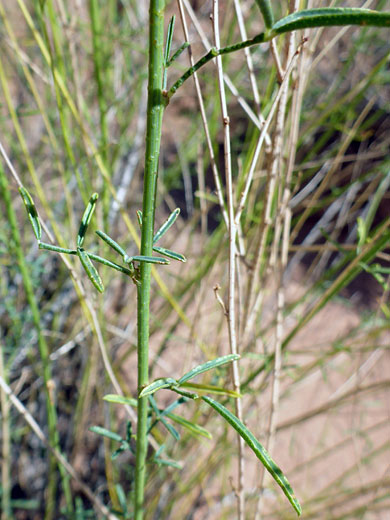
Clawed petals of dalea candida var oligophylla - Syncline Loop Trail, Canyonlands National Park, Utah
Common name:
White prairie clover
Family:
Scientific name:
Dalea candida
Main flower color:
Range:
The Rocky Mountain and Great Plains states, and some adjacent areas
Height:
Between 8 and 40 inches
Habitat:
Open woodland, scrubland, roadsides, canyons, dry hillsides; up to 8,000 feet
Leaves:
Alternate, divided into 3, 5 or 7 (less often 9) narrow, linear leaflets, each up to 2 inches long
Season:
June to September
The inflorescence of dalea candida is a compact or elongated (up to 4 inches tall) cluster of sessile flowers, which are atypical of the fabaceae family; they are formed of five clawed, white petals, all generally similar in appearance though one (the banner) is somewhat wider than the others. Petals are arranged around five stamens, which have white filaments and brownish-yellow anthers, and are a little shorter than the petals, and also one white, slightly curved style, exserted beyond the petals. Below the petals is a yellowish calyx with five green lobes, hairy along their margins. Each flower is subtended by a small bract.
Leaves grow at the base and at wide intervals along the stem, where they are reduced in size. The hairless leaves are odd pinnate; divided into a terminal leaflet and one, two or three pairs of lateral leaflets. The base of the leaf stalk is flanked by two short, hair-like stipules. The green stems are stout, usually growing vertically upwards.
Most specimens of this plant are var oligophylla; the less common var candida (mostly found in the eastern US) is characterized by smaller leaves and leaning rather than vertical stems.
Leaves grow at the base and at wide intervals along the stem, where they are reduced in size. The hairless leaves are odd pinnate; divided into a terminal leaflet and one, two or three pairs of lateral leaflets. The base of the leaf stalk is flanked by two short, hair-like stipules. The green stems are stout, usually growing vertically upwards.
Most specimens of this plant are var oligophylla; the less common var candida (mostly found in the eastern US) is characterized by smaller leaves and leaning rather than vertical stems.
All Contents © Copyright The American Southwest | Comments and Questions | Contribute | Site Map



